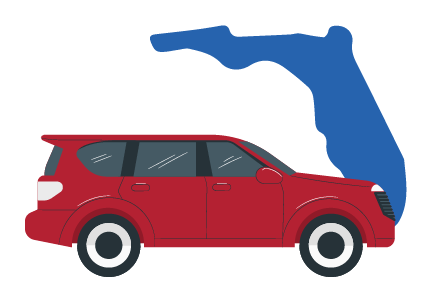To legally drive in Indiana in 2025, you must have liability insurance that meets the state’s minimum coverage requirements. Most states in the US have this requirement so vehicle owners are financially responsible in case of an auto accident. Liability insurance (also known as coverage for financial responsibility) is the way drivers meet Indiana auto insurance requirements.
Car insurance is a legal requirement for driving and plays a big part in settling accident claims. After an accident, auto insurance policies provide the financial means to fix damages and injuries caused by the insured driver. Proof of insurance must be in the vehicle and presented to law enforcement when asked.
Minimum insurance requirements for Indiana
To drive a vehicle in Indiana, you must carry liability insurance that meets the state’s minimum coverage requirements. These minimums are designed to hold you financially responsible in the event of an accident. These minimums are commonly referred to as split limits. They are $25,000/$50,000/$25,000, which is the maximum amount the insurance company will pay per claim under each category of auto liability coverage.
Indiana car insurance requirements for Liability Insurance are listed below.
- $25,000 for bodily injury liability coverage per person: This is the maximum amount your insurance will pay for medical expenses if one person is injured in an accident you cause.
- $50,000 for bodily injury liability coverage per accident: This is the total amount of money the insurance company will payout for all injuries from a single accident if multiple people are hurt.
- $25,000 for property damage liability coverage per accident: This is the maximum amount the insurance company will pay for damage to someone else’s property or vehicle due to your fault in a collision.
Liability insurance also provides a lawyer on your behalf if a lawsuit arises from an accident you cause. Bodily injury liability pays for medical expenses, lost wages, and other costs for injured people in an accident. Property damage liability pays for repairs or replacement of a vehicle or other damaged property from a car accident.
While these liability policy limits meet the legal requirements, they may not be enough for major accidents. If damages exceed these minimum limits, the at-fault driver becomes personally liable for the rest of the damages. So, purchasing higher liability coverage limits from your insurance provider is highly recommended to protect your personal assets from a large insurance claim.
Are Indiana’s Minimum Auto Insurance Requirements adequate coverage?
Indiana’s minimum liability limits are like those of many other states but may not be enough in real life. The minimums are $25,000 per person, $50,000 per accident for bodily injury, and $25,000 for property damage. Those could be gone fast in a serious accident. For example, medical bills can add up quickly if multiple people are injured. Suppose the average cost of a new vehicle is $25,000. Property damage coverage may not cover the repair or replacement cost in that case.
Plus, Indiana’s minimum car insurance requirements only include liability coverage, which pays for injuries and damages you cause to others. It doesn’t cover your medical bills or damage to your vehicle. To get comprehensive coverage, you must add optional coverages, like collision coverage, which pays for your vehicle’s repairs or replacement regardless of who is at-fault.
So, it’s a good idea to increase your liability limits and add coverages based on your financial situation and risk. That will give you critical financial security and peace of mind in a significant or costly accident.
Optional Indiana Auto Insurance Coverages
While Indiana car insurance laws only require liability insurance to drive legally, you can greatly increase your financial protection by adding additional coverages to your car insurance policy. These extra coverage options help pay for repairs, medical treatment, and unexpected events that liability insurance doesn’t cover.
Additional Auto insurance coverages for Indiana Drivers to consider are listed below.
- Comprehensive Coverage: This covers your vehicle for non-collision damages. Damages like theft, vandalism, fire, falling objects, natural disasters, broken glass, or hitting an animal.
- Collision Coverage: Pays for repairs or replacement of your vehicle if it’s damaged in a collision, regardless of which driver is at-fault.
- Uninsured/Underinsured Motorist Coverage: This covers you if you’re in an accident with an uninsured or underinsured driver. This includes both bodily injury and property damage.
- Medical Payments Coverage (Med Pay): Pays for medical or funeral expenses for you and your passengers after an accident, regardless what driver was at-fault.
- Rental Reimbursement: Pays for a rental car if your car is undrivable after an accident or if your car is totaled.
- Roadside Assistance: Covers common roadside emergencies like dead batteries, flat tires, lockouts, fuel delivery, and towing.
- Gap Coverage: Gap coverage is usually required for leased or financed vehicles. This coverage pays the difference between your vehicle’s current value and the balance on your loan or lease if your car is totaled.
- Accident Forgiveness: Accident forgiveness is only available with certain insurance companies. If your insurance company offers this coverage, it helps you avoid an insurance rate increase after your first car accident.
Additional coverages let Indiana drivers customize their auto insurance policy to their needs. By Covering a wide range of possible scenarios, drivers don’t have to worry if an unexpected car accident happens.
Penalties for Driving without Insurance in Indiana
Driving without car insurance in Indiana is a serious offense with hefty financial and legal consequences. The state has strict rules requiring all drivers to meet their financial obligations and cover the costs of an accident.
The Penalties for Driving Without Auto Insurance in Indiana are listed below.
- Fines: First time offenders can face fines of $250 to $1,000. Repeat offenders face even higher fines of $500 for a second offense and $1,000 for a third. That’s a steep price to pay for driving uninsured.
- Drivers License Suspension: Your driving privileges can be suspended for up to 90 days after a first offense. If you continue to drive without insurance, suspensions can get longer, and getting your license back can be more difficult.
- SR-22 Requirement: You’ll likely need to file an SR-22 form, a certification of financial responsibility with the state. That means higher insurance premiums for three years, depending on your driving history.
- Vehicle Impoundment: Sometimes, your vehicle will be towed until you show proof of insurance along with high impound fees.
- Lawsuits: If you get into an accident without insurance, you’ll be personally responsible for all the costs such as medical bills, car repairs, and more. In the worst cases, you could face lawsuits and long term financial obligations like a court judgement or garnishment of your wages.
- Higher Auto Insurance Rates: Once you’re labeled a high-risk driver after being cited for driving without insurance, your insurance rates will go through the roof.
Driving uninsured is riskier than the cost of having the required minimum liability insurance in Indiana. Having valid auto insurance keeps you on the right side of the law. It protects you financially if you get into an accident.
SR-22 Insurance and High-Risk Drivers in Indiana
In Indiana, high-risk drivers may be required to carry SR-22 insurance. This is known as a Certificate of Financial Responsibility. An SR-22 is for drivers whose license has been suspended due to traffic violations like a DUI, multiple at-fault accidents, repeated license suspensions, or getting caught driving without insurance.
The SR-22 is not an insurance policy itself but a form your insurer files electronically with the Indiana Bureau of Motor Vehicles (BMV). The SR-22 is proof you have the state’s minimum auto insurance requirements. To reinstate your license or keep your driving privileges after a suspension, the SR-22 must be on file and active for 180 days. Coverage lapses or policy cancellations will cause your license to be suspended immediately.
If your insurance company cancels your policy, they will submit an SR-26, known as a notice of cancellation.
Your drivers license will be suspended until you provide proof of insurance, if the BMV doesn’t have an active SR-22 on file. Continuous compliance with SR-22 requirements is needed for high-risk drivers to get their licenses back in Indiana.
Why You Must Meet Indiana Car Insurance Requirements
Complying with Indiana car insurance law is the best way to avoid fines and protect yourself financially in case of an accident. Accidents are unpredictable and costly, especially if you only have minimum coverage. Carrying only the state’s minimum liability limits will leave you paying out of pocket for medical bills, property damage, or lawsuits.
To be more protected on the road, it’s a good idea to increase your liability limits and add optional coverages like collision, comprehensive, or uninsured motorist coverage.
Comparing car insurance rates from multiple insurance companies is the best way to get affordable coverage that fits your budget and the level of protection you want.
Contact an insurance agent today to get a personalized car insurance quote. Drive with peace of mind, knowing you and your assets are covered.
Frequently Asked Questions
What is the minimum liability coverage needed to drive in Indiana legally?
Indiana law requires at least $25,000 in bodily injury coverage per person, $50,000 total bodily injury coverage per accident, and $25,000 in property damage (25/50/25). These minimum requirements are to ensure you can pay for damages if you get into an accident.
Does Indiana require uninsured motorist coverage on every auto policy?
Indiana requires insurers to add uninsured/underinsured motorist coverage with limits of 25/50 bodily injury liability and $25,000 in property damage liability. But you can reject this coverage in writing if you want to.
What proof of insurance must I carry while driving?
Indiana requires you to carry proof of insurance whenever your driving a vehicle. Acceptable forms are printed insurance ID cards, digital insurance cards on your phone, or a certificate of compliance from the Bureau of Motor Vehicles (BMV).
Will the BMV check my insurance even if I’m not pulled over?
The BMV does random and event-based electronic checks to verify insurance compliance. They may also request proof of insurance by mail after an accident, traffic conviction, or other triggering events.
How long do I have to respond to a BMV insurance verification request?
When the BMV sends you an insurance verification request, you have 40 days to have your insurer electronically submit proof of coverage. Your license will be suspended if you don’t respond within that time frame.
What happens if I’m caught driving without insurance for the first time?
Suppose you’re caught driving without insurance in Indiana for the first time. In that case, you’ll get a 90-day license suspension, have to pay reinstatement fees, and file an SR-22 with the state as proof of future financial responsibility.
Is Indiana a no-fault state?
No, Indiana is an at-fault state. This means the driver who causes the accident is financially responsible for the damages and injuries.
What does it mean Indiana is a diminished value state?
As a state with diminished value, Indiana allows vehicle owners to seek compensation for the decreased value of their vehicle after it’s been repaired from an accident. To successfully claim this, you must show both the depreciation and that another driver (or an uninsured driver) was at fault.





